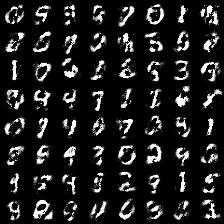import sys; sys.path.append("/home/hxj/anaconda3/lib/python3.6/site-packages") import numpy as np import tensorflow as tf from PIL import Image from tensorflow.examples.tutorials.mnist import input_data #这里为了加快速度,先下载好再导入 mnist = input_data.read_data_sets(‘MNIST_data‘, one_hot=True) print("##################") def combine(image): assert len(image) == 64 rows = [] for i in range(8): cols = [] for j in range(8): index = i * 8 + j img = image[index].reshape(28, 28) cols.append(img) row = np.concatenate(tuple(cols), axis=0) rows.append(row) new_image = np.concatenate(tuple(rows), axis=1) return new_image.astype("uint8") def dense(inputs, shape, name, bn=False, act_fun=None): W = tf.get_variable(name + ".w", initializer=tf.random_normal(shape=shape)) b = tf.get_variable(name + ".b", initializer=(tf.zeros((1, shape[-1])) + 0.1)) y = tf.add(tf.matmul(inputs, W), b) def batch_normalization(inputs, out_size, name, axes=0): mean, var = tf.nn.moments(inputs, axes=[axes]) scale = tf.get_variable(name=name + ".scale", initializer=tf.ones([out_size])) offset = tf.get_variable(name=name + ".shift", initializer=tf.zeros([out_size])) epsilon = 0.001 return tf.nn.batch_normalization(inputs, mean, var, offset, scale, epsilon, name=name + ".bn") if bn: y = batch_normalization(y, shape[1], name=name + ".bn") if act_fun: y = act_fun(y) return y def D(inputs, name, reuse=False): with tf.variable_scope(name, reuse=reuse): l1 = dense(inputs, [784, 512], name="relu1", act_fun=tf.nn.relu) l2 = dense(l1, [512, 512], name="relu2", act_fun=tf.nn.relu) l3 = dense(l2, [512, 512], name="relu3", act_fun=tf.nn.relu) y = dense(l3, [512, 1], name="output") return y def G(inputs, name, reuse=False): with tf.variable_scope(name, reuse=reuse): l1 = dense(inputs, [100, 512], name="relu1", act_fun=tf.nn.relu) l2 = dense(l1, [512, 512], name="relu2", act_fun=tf.nn.relu) l3 = dense(l2, [512, 512], name="relu3", act_fun=tf.nn.relu) y = dense(l3, [512, 784], name="output", bn=True, act_fun=tf.nn.sigmoid) return y z = tf.placeholder(tf.float32, [None, 100], name="noise") # 100 x = tf.placeholder(tf.float32, [None, 784], name="image") # 28*28 real_out = D(x, "D") gen = G(z, "G") fake_out = D(gen, "D", reuse=True) vars = tf.trainable_variables() D_PARAMS = [var for var in vars if var.name.startswith("D")] G_PARAMS = [var for var in vars if var.name.startswith("G")] d_clip = [tf.assign(var, tf.clip_by_value(var, -0.01, 0.01)) for var in D_PARAMS] d_clip = tf.group(*d_clip) # 限制参数 wd = tf.reduce_mean(real_out) - tf.reduce_mean(fake_out) d_loss = tf.reduce_mean(fake_out) - tf.reduce_mean(real_out) g_loss = tf.reduce_mean(-fake_out) d_opt = tf.train.RMSPropOptimizer(1e-3).minimize( d_loss, global_step=tf.Variable(0), var_list=D_PARAMS ) g_opt = tf.train.RMSPropOptimizer(1e-3).minimize( g_loss, global_step=tf.Variable(0), var_list=G_PARAMS ) is_restore = False # is_restore = True # 是否第一次训练(不需要载入模型) sess = tf.Session() sess.run(tf.global_variables_initializer()) if is_restore: saver = tf.train.Saver() # 提取变量 saver.restore(sess, "my_net/GAN_net.ckpt") print("Model restore...") CRITICAL_NUM = 5 for step in range(100 * 1000): if step < 25 or step % 500 == 0: critical_num = 100 else: critical_num = CRITICAL_NUM for ep in range(critical_num): noise = np.random.normal(size=(64, 100)) batch_xs = mnist.train.next_batch(64)[0] _, d_loss_v, _ = sess.run([d_opt, d_loss, d_clip], feed_dict={ x: batch_xs, z: noise }) for ep in range(1): noise = np.random.normal(size=(64, 100)) _, g_loss_v = sess.run([g_opt, g_loss], feed_dict={ z: noise }) print("Step:%d D-loss:%.4f G-loss:%.4f" % (step + 1, d_loss_v, g_loss_v)) if step % 1000 == 999: batch_xs = mnist.train.next_batch(64)[0] # batch_xs = pre(batch_xs) noise = np.random.normal(size=(64, 100)) mpl_v = sess.run(wd, feed_dict={ x: batch_xs, z: noise }) print("################## Step %d WD:%.4f ###############" % (step + 1, mpl_v)) generate = sess.run(gen, feed_dict={ z: noise }) generate *= 255 generate = np.clip(generate, 0, 255) image = combine(generate) Image.fromarray(image).save("image/Step_%d.jpg" % (step + 1)) saver = tf.train.Saver() save_path = saver.save(sess, "my_net/GAN_net.ckpt") print("Model save in %s" % save_path) sess.close()
实验结果
训练1000次
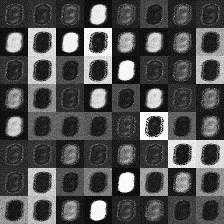
训练9000次
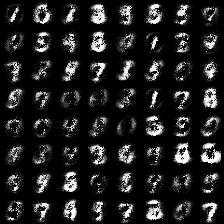
训练15000次
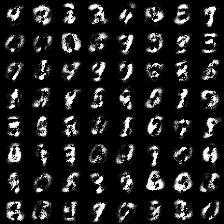
训练25000次
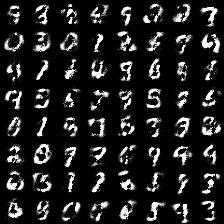
训练3300次
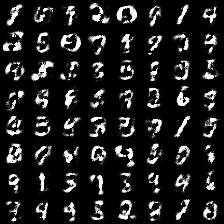
训练42000次
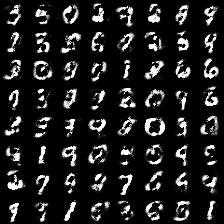
训练5000次
